The Year in Review
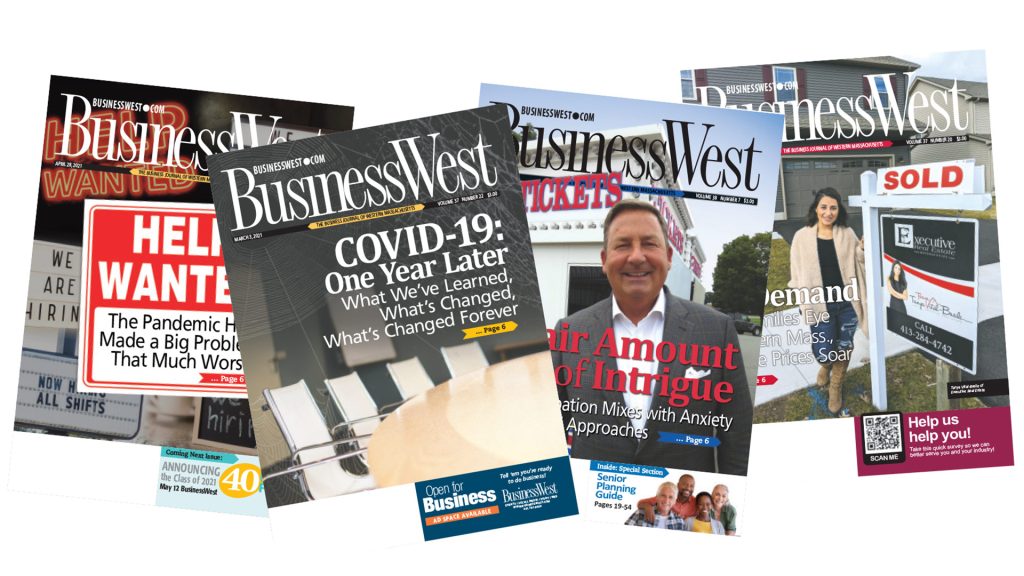
You could have called it ‘COVID — year 2.’ Many people did. It was supposed to be the year the pandemic was put in the rear view. But it didn’t work out that way. Instead, 2021 was a year in which COVID-19 not only stayed with us, but multiplied its impact in numerous ways, especially within the business community. The shutdowns, heavy restrictions, canceled events, and long lines for testing in 2020 gave way to vaccinations, a general reopening of the economy, and the return of many events and institutions — from the Big E to the Thunderbirds to the local chambers’ After-5 gatherings — in 2021. But there was also inflation, supply-chain issues, a workforce crisis, profound changes in how and where work is done, and something that came to be known as the Great Resignation. But it was also a year when the local cannabis industry continued to grow and broaden its already significant impact on the region, Smith & Wesson announced it was moving its headquarters to Tennessee, tourism bounced back in a big way, and the region lost one its iconic entrepreneurs and restaurateurs. It was another year to remember — or forget, depending on your point of view. With that, here’s a look back at the biggest stories of the past year.
COVID-19
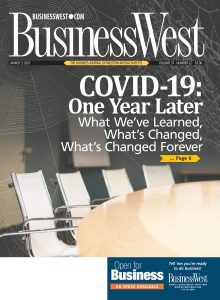 Actually, COVID wasn’t one story; it was perhaps a dozen different stories all happening at once, some of which you’ll read about below. There was the virus itself, which evolved into different variants, including Delta and, most recently, Omicron. But there were many side effects from the pandemic, each one being a big story in its own way.
Actually, COVID wasn’t one story; it was perhaps a dozen different stories all happening at once, some of which you’ll read about below. There was the virus itself, which evolved into different variants, including Delta and, most recently, Omicron. But there were many side effects from the pandemic, each one being a big story in its own way.
That list includes vaccinations — and there are several different aspects to that story — and also ongoing changes to the workplace, a workforce crisis spawned in many ways by the pandemic, supply-chain shortages, inflation generated by huge amounts of money being infused into the economy at a time when there were shortages of many items, and much more.
The news that everyone had been waiting for — the lifting of all restrictions placed on businesses as a result of COVID — came just before Memorial Day. BusinessWest announced this critical turn with the cover headline ‘The Next Stage.’ In actuality, the next stage wasn’t all that most businesses thought it would be, as many of them were now facing new challenges, such as severe labor shortages, the inability to order parts and supplies, lingering issues regarding remote work, and, much later, matters regarding vaccination (more on all these later).
“In most all respects, things were much better in 2021 than they were in 2020, but ‘normal,’ as in pre-COVID, was elusive for many businesses, large and small.”
Still, in most all respects, things were much better in 2021 than they were in 2020, but ‘normal,’ as in pre-COVID, was elusive for many businesses, large and small. From car dealerships with very few new cars on the lots — and used cars taking up showroom space — to restaurants having to close an extra day during the week because they couldn’t get enough help, there were many signs that the pandemic wasn’t going to be relegated to the past tense any time soon. And with the number of cases and hospitalizations spiking this month, it seems certain there will be a ‘year 3’ of COVID — and, for now, great uncertainty about what that will bring.
The Workforce Crisis
Perhaps the most enduring image from this past year, at least within the business community, was the help-wanted sign. It appeared in the window of every kind of business imaginable, from restaurants to manufacturing plants; from roofing companies to landscapers; from golf courses to supermarkets. The list goes on. Everyone was looking for help. And most of them still are.
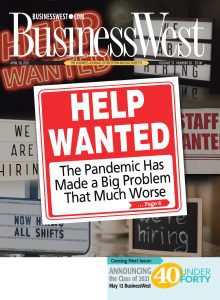 Indeed, what can only be called a workforce crisis shows no signs of letting up, with signs saying ‘Help Wanted,’ ‘Join Our Team,’ and ‘We’re Hiring’ still dominating the landscape. BusinessWest covered the story extensively and from many different angles in 2021, interviewing everyone from law-firm managing partners to hospital administrators to restaurant owners. They were all saying the same thing: good help is very hard to find, and for many reasons.
Indeed, what can only be called a workforce crisis shows no signs of letting up, with signs saying ‘Help Wanted,’ ‘Join Our Team,’ and ‘We’re Hiring’ still dominating the landscape. BusinessWest covered the story extensively and from many different angles in 2021, interviewing everyone from law-firm managing partners to hospital administrators to restaurant owners. They were all saying the same thing: good help is very hard to find, and for many reasons.
For much of the year, one of the presumed factors was attractive (many would say too attractive) federal unemployment benefits. But when those benefits ended in September, the problem did not improve appreciably. Meanwhile, the workforce crisis has had a number of side effects of its own, including higher wages, the need for sign-on bonuses and other incentives, and, most importantly, lost business opportunities from simply not having enough help. And the matter of finding help became greatly complicated by the growing need for help.
“Perhaps the most enduring image from this past year, at least within the business community, was the help-wanted sign. It appeared in the window of every kind of business imaginable.”
That’s why the phrase ‘Great Resignation’ entered the lexicon in 2021, a reference to the millions of people who left their jobs over the course of the year for reasons ranging from the ability to retire early to job dissatisfaction to mandated vaccinations. Overall, it was a good year to be looking for work, and a very difficult year for those looking for help.
Inflation and the Supply Chain
‘The Rising Cost of Everything.’ That was the headline on a BusinessWest cover story in late May. That same headline could have worked in every month since. Indeed, the price of just about everything, from steak to lumber to used cars, kept heading skyward.
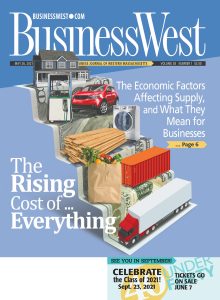 Last month, in fact, inflation hit its highest point in almost 40 years. The Consumer Price Index, which tracks the price of a broad range of goods, rose 0.8% in November and is up 6.8% from a year earlier. The biggest risers included food, housing, cars (both new and used), and gasoline. Energy costs in November were up 33% over a year earlier, food costs were up 6%, and used car and truck prices climbed 31%.
Last month, in fact, inflation hit its highest point in almost 40 years. The Consumer Price Index, which tracks the price of a broad range of goods, rose 0.8% in November and is up 6.8% from a year earlier. The biggest risers included food, housing, cars (both new and used), and gasoline. Energy costs in November were up 33% over a year earlier, food costs were up 6%, and used car and truck prices climbed 31%.
The most recent echo of such severe inflation took place in the 1970s, a situation spurred by disruptions in global oil supplies. Inflation rose from below 3% in 1972 to above 13% in 1979, prompting the Federal Reserve to hike interest rates to as high as 20%. By 1982, inflation had receded, but the experience shaped monetary policy for decades.
“One of the main drivers to the current inflation crisis, of course, has been a broken global supply chain — an issue with so many interlocking factors, it’s hard to see it resolving any time soon.”
One of the main drivers to the current inflation crisis, of course, has been a broken global supply chain — an issue with so many interlocking factors, it’s hard to see it resolving any time soon. The earliest factor was a widespread economic shutdown in the spring of 2020; when the economy began reopening at high speed later that year, supply chains — for products like steel, lumber, and other key supplies — were slow to respond to growing consumer demand, and never caught up.
Add in serious delays in freight shipping, a bottleneck of shipping containers across the globe, and a persistent shortage of workers, and the result is additional strain on businesses and soaring prices all the way down the supply line — which eventually reach consumers in the form of, you guessed it, inflation. Untangling all of this will be one of the big challenges facing policymakers and business leaders in 2022.
Changes in the Workplace
If 2020 was the year of remote work, then 2021 was the year of deciding if, when, and under what circumstances people would continue to work remotely. And for many businesses, deciding just what to do became a stern challenge.
Many arrived at a hybrid format as the most common-sense solution, a mixed approach that had employees working remotely most days but in the office at least one or two. However, many employees, citing how well they worked at home, questioned whether the hybrid approach was needed or even effective.
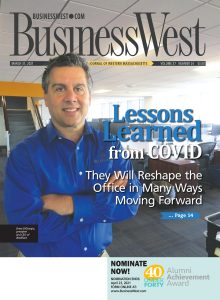 Meanwhile, the changing dynamic created still more challenges for those confronting the ongoing workforce challenge. Indeed, beyond salary, benefits, and workplace culture, many job seekers put the ability to work remotely high on their wish list — or demand list, as the case may be.
Meanwhile, the changing dynamic created still more challenges for those confronting the ongoing workforce challenge. Indeed, beyond salary, benefits, and workplace culture, many job seekers put the ability to work remotely high on their wish list — or demand list, as the case may be.
Sarah Rose Stack, recruiting director for Holyoke-based Meyers Brothers Kalicka, summed things up poignantly in a piece she wrote for BusinessWest in October. “Employees are actively seeking remote or hybrid work opportunities just as many companies are now demanding that employees return to in-person work,” she explained. “Some have even pre-emptively started seeking flexible work opportunities out of fear that their current remote-work situation might change. Many are expressing that the ability to work from home and have more flexible work schedules in general have helped to prevent burnout. People have enjoyed ditching the morning commute and 5 p.m. rush hour. The returned pockets of time have come with myriad benefits, including more sleep, more time with family before and after work, less wear and tear on vehicles, more time with pets, and an overall more comfortable environment.”
“If 2020 was the year of remote work, then 2021 was the year of deciding if, when, and under what circumstances people would continue to work remotely. And for many businesses, deciding just what to do became a stern challenge.”
But while remote work presents challenges, there are opportunities for businesses as well; managers in many different sectors told BusinessWest that remote work gives them the opportunity to recruit talent from across the country, not simply from within the 413. That same opportunity could be a boon for this region and, especially, rural areas like the Berkshires and Franklin County, which offer quality of life, lower cost of living, and, now, an opportunity to live there and work almost anywhere. Like many of the stories on our list, this one will take some time to play out.
Smith & Wesson Heads to Tennessee
The press release found its way into the inbox of area media outlets early in the morning of Sept. 30. And it was a bombshell. Smith & Wesson President Mark Smith was announcing that the company was moving its corporate headquarters — and roughly 500 jobs — from Springfield, where the company was launched more than 150 years ago, to Blount County, Tennessee.
The stated reason was that the company did not want to remain headquartered in a state where legislation had been filed that would ban the manufacturing of more than half the products (specifically assault weapons) made by the company. Smith & Wesson’s new home is a county that bills itself as a ‘Second Amendment sanctuary.’
While the stated case for leaving was greeted with significant skepticism — many elected officials stated that the company was simply taking advantage of huge tax breaks and other incentives — there was considerable discussion about just what Springfield and this region would be losing. The 500 jobs were at the top of that list, obviously, but some were saying the city was also losing some of its business and manufacturing heritage (even if 1,000 of the company’s jobs were staying in the city) and some bragging rights, given that S&W is among the most recognizable brands in the world.
As for the lost jobs, some elected officials, and some area manufacturers as well, see this as an opportunity for the region, given the ongoing workforce crisis and shortage of good help (see how the stories on this list are all interconnected?). One firm, Indian Orchard-based Eastman, actually started advertising directly to those impacted Smith & Wesson workers, welcoming them to seek work at that firm.
Cannabis Continues to Flourish
In the three years and one month since NETA opened on Conz Street in Northampton and became the state’s very first dispensary for legal, recreational cannabis, almost 200 cannabis businesses — not just retail shops, but growers, manufacturers, labs, and wholesalers — have cropped up across Massachusetts. Last month, total sales in Massachusetts crossed the $2 billion mark … and the second billion arrived in a much shorter timespan than the first billion.
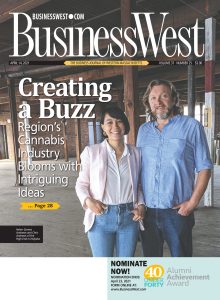 What this tells industry proponents is that constant expansion of competition isn’t simply spreading out a limited pool of customers; it’s creating more, and many believe there remains a significant well of individuals who haven’t yet turned on, but will eventually, as they hear good things from friends and family and the last barriers of stigma fall.
What this tells industry proponents is that constant expansion of competition isn’t simply spreading out a limited pool of customers; it’s creating more, and many believe there remains a significant well of individuals who haven’t yet turned on, but will eventually, as they hear good things from friends and family and the last barriers of stigma fall.
Locally, that’s good news on a couple of economic fronts: municipal tax revenues and jobs. In Northampton, for instance, which boasts at least 20 cannabis-related businesses, excise taxes have brought in more than $4.3 million over three years, to help pay for much-neede city services. And just down the road in Holyoke, a surge in employment in this new industry — hundreds of jobs and counting in that city alone — has led to new job-training programs to feed the growing demand.
If there has been one hiccup, the Cannabis Control Commission’s stated commitment to social-equity opportunities — with the goal of helping communities and demographics negatively impacted by the war on drugs to access entrepreneurship opportunities in cannabis — has met with inconsistent results. But commissioners have heard those complaints, and the conversation continues.
“Last month, total sales in Massachusetts crossed the $2 billion mark … and the second billion arrived in a much shorter timespan than the first billion.”
Meanwhile, the sheer number of cannabis businesses in Massachusetts is actually making it easier for all players — even small ones — to succeed, because of the cross-pollination making vertical integration less of a necessity these days. It’s an industry of many niches, and every niche is reporting tremendous oppportunity.
Tourism Industry Rebounds
While full recovery is still a ways off, the region’s large and vital tourism and hospitality industry staged an inspiring comeback in 2021. The biggest story, on many levels, was the return of the Big E after a one-year hiatus due to COVID. The 17-day fair drew large crowds — nearly 1.5 million in total — and on the final Saturday, it topped the all-time single-day attendance mark with 177,238 visitors.
 Meanwhile, the fair boosted the fortunes of a number of other businesses, from hotels and restaurants to tent-renting companies. But there were other signs of progress as well, including solid visitation numbers at a renovated Basketball Hall of Fame, the return of live performances at Jacob’s Pillow and a host of other cultural venues, a steady if unspectacular year for MGM Springfield, and, of course, the return of the Springfield Thunderbirds, which were in first place as of this writing.
Meanwhile, the fair boosted the fortunes of a number of other businesses, from hotels and restaurants to tent-renting companies. But there were other signs of progress as well, including solid visitation numbers at a renovated Basketball Hall of Fame, the return of live performances at Jacob’s Pillow and a host of other cultural venues, a steady if unspectacular year for MGM Springfield, and, of course, the return of the Springfield Thunderbirds, which were in first place as of this writing.
As for restaurants, they rebounded as well, with patrons returning in large numbers, especially after the state lifted all restrictions on such businesses just before Memorial Day. But for most all restaurants, reopening came with challenges, especially on the workforce side, with many forced to close more than one day a week (the traditional number) because of a lack of workers.
“While full recovery is still a ways off, the region’s large and vital tourism and hospitality industry staged an inspiring comeback in 2021. The biggest story, on many levels, was the return of the Big E after a one-year hiatus due to COVID.”
As for hotels and event venues, weddings and similar events returned in full force, but the story was different on the corporate side, with travel and events still well below pre-COVID levels. So, while the tourism sector has recovered to some degree, there is still some work to do.
The Vaccination Issue
Businesses already facing a number of challenges as a result of COVID were handed another with the arrival of vaccinations to combat the virus.
The efficacy of vaccines isn’t in doubt. While they don’t totally prevent spread or infection, their impact on severity is well-documented, with hospital ICUs reporting that 95% or more of the most severe cases — and deaths — in 2021 have been among the unvaccinated. And those deaths are nothing to scoff at. As the pandemic approaches the end of a second year, the U.S. is about to surpass 800,000 deaths from the virus, hitting the elderly the hardest; roughly one in 100 older Americans has died from the virus, while, for people younger than 65, that ratio is closer to 1 in 1,400.
So it’s natural that business and political leaders have been frustrated by vaccine hesitancy among wide swaths of Americans. While the vaccines have certainly prompted decreases in cases, hospitalizations, and deaths from COVID, they have left employers with hard decisions — and some dilemmas.
“While the vaccines have certainly prompted decreases in cases, hospitalizations, and deaths from COVID, they have left employers with hard decisions — and some dilemmas.”
Many business owners didn’t want to be in a position to require vaccinations, but this fall, the Biden administration made the decision for them, requiring vaccinations for all businesses with more than 100 employees and those working on federal contracts (or subcontracts), healthcare workers, and federal government workers.
Legal challenges have gone back and forth on these vaccination mandates, putting the mandate for federal workers in limbo for a time (though it’s back on for the time being), while private employers moving forward with the mandate must cope with employees leaving because they don’t wish to be vaccinated, adding to an already-difficult workforce environment. It’s another story that will play itself out over the coming weeks and months.
Data Center Proposed in Westfield
It’s being called the largest private-sector development proposal in the region’s history. That some of the language attached to a plan to build a $2.7 billion data center on a 165-acre parcel off Servistar Industrial Way in Westfield.
The proposal’s developers, Servistar Industrial Realties, have presented plans calling for a complex of 10 buildings totaling more than 2.74 million square feet, with projected customers expected to include the likes of Google, Microsoft, Amazon, Apple, and Facebook. The project, which still has a number of hurdles to clear before it becomes reality, has received approval from the Planning Board and City Council, with the state now considering a 40-year tax-abatement package.
The developers focused in on Westfield and the large parcel in question — actually, several smaller parcels knitted together — because the site could check a number of boxes, including the ability to draw power, and large amounts of it, directly from the grid, as well as access to a reliable, high-speed fiber communications network. Competitive cost of doing business is also high on the list, as is a skilled workforce and easy access to major markets.
Area economic-development officials note that, while sites for such massive initiatives, called ‘hyperscale’ projects, are rare, there is the potential for smaller-scale data-center ventures, and success with the Westfield project could create other opportunities for the region.
Housing Prices Soar
Have you tried to buy a house lately? How frustrating has it been?
Probably plenty frustrating, because of a simple supply-and-demand equation: there are far fewer available houses on the market, especially in Western Mass., than there are buyers, and that’s caused prices to soar. Homes are often publicly on the market for a day or two before they’re snapped up, often at more than the asking price, sometimes without an inspection.
 Statistics from the Realtor Assoc. of Pioneer Valley bear this out. Last December, home sales in the Pioneer Valley were up 29.2%, and median price was up 10.1%, from December 2019. And the trend has continued through 2021, with sales down slightly from 12 months earlier, but the median price up another 15%.
Statistics from the Realtor Assoc. of Pioneer Valley bear this out. Last December, home sales in the Pioneer Valley were up 29.2%, and median price was up 10.1%, from December 2019. And the trend has continued through 2021, with sales down slightly from 12 months earlier, but the median price up another 15%.
A few different factors have been in play. Since the start of the pandemic, especially since the advent of widespread remote work, families have been trying to escape urban areas, driving sales in Berkshire and Franklin counties, but also in more populous Hampden and Hampshire counties as well. Demand has outpaced supply, and home buyers aren’t putting their own houses on the market until they’ve got a new home nailed down.
Meanwhile, interest rates have been at historic lows, even creeping below 3%. “The rates are so low that a lot of people are realizing it’s much cheaper than renting,” Realtor Tanya Vitale-Basile told BusinessWest earlier this year, adding that sellers from the Boston area find they can get much more living space for their money in the Pioneer Valley.
In short, families spending much more time at home have decided they want a different one — and for many, it’s been tough to buy one.
Other Stories from 2021
There were many of them, including the death in May of serial entrepreneur and restaurateur Andy Yee. What would have been his 60th birthday a few weeks later was one of the bigger parties of the year. It was a celebration of a life well-lived.
There was a loss of another kind in late November, when a four-alarm fire ravaged the Maple Center Shopping Plaza in Longmeadow, which left five businesses, which collectively employed 74 people, homeless. The community has rallied around the business owners and employees to help them recover.
In news that affects businesses of all kinds, 2021 will be a record-breaking year for data breaches. According to Identity Theft Resource Center research, the total number of data breaches through three quarters has already exceeded the total number of events in 2020 by 17%, with 1,291 breaches from January through September 2021 compared to 1,108 breaches in 2020.
Ambitious proposals for east-west rail, connecting Pittsfield and Boston along the southern half of the state and North Adams and Boston up north, have gained steam, with MassDOT just last week convening stakeholders and launching a study of the latter. Meanwhile, north-south service on the Amtrak Valley Flyer and Vermonter lines was restored over the summer after pandemic cutbacks.
“In news that affects businesses of all kinds, 2021 will be a record-breaking year for data breaches. According to Identity Theft Resource Center research, the total number of data breaches through three quarters has already exceeded the total number of events in 2020 by 17%, with 1,291 breaches from January through September 2021 compared to 1,108 breaches in 2020.”
Plans by Carvana to build a large car-processing facility in Southwick were scuttled over the summer when the company withdrew its proposal hours before a public meeting where residents were expected to oppose it by a wide margin, mainly due to traffic concerns.
One ongoing story from 2021 is an apparent surge in entrepreneurship prompted by COVID and its many side effects. Indeed, the pandemic left many with the time and inclination to move on with their dreams of owning their own businesses, and many of them seized the opportunity, with new ventures ranging from breweries to a Latino marketing agency to a wine-distribution business.
As for BusinessWest, it was a busy year, especially when it came to events. Due to COVID, there were actually six this year, with two slated for late in 2020 rescheduled for this past January. Live events returned with a raucous 40 Under Forty gala at the Log Cabin in September, followed by the Healthcare Heroes and Women of Impact celebrations in October and December, respectively. Nominations are open for these recognition programs for 2022.
"many" - Google News
December 22, 2021 at 05:58PM
https://ift.tt/3H5GfA1
COVID and Its Many Side Effects Dominate the Headlines - Business West
"many" - Google News
https://ift.tt/2OYUfnl
https://ift.tt/3f9EULr
No comments:
Post a Comment